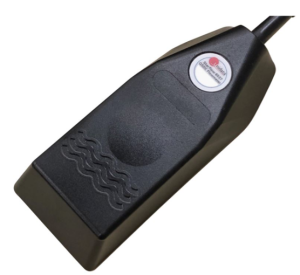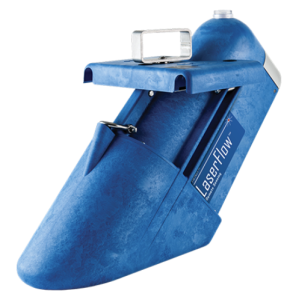Being able to quantify flow is very important for being able to manage the liquids on your site. This month let’s look at three very different technologies for measuring flow available in the HydroTerra marketplace. All three technologies measure flow differently depending on the type of flow to be measured.
1. Unidata Starflow QSD
 The QSD is a doppler flowmeter that measures velocity by sending an ultrasonic signal into the flow and calculating velocity from the doppler shift in frequency from the particles and bubbles in the flow returning to it. It also measures depth of the flow both by measuring the distance to the surface of the flow with an ultrasonic signal and/or using a pressure transducer. When used with a companion Unidata IP data logger, flow rate and total flow can also be calculated. The 6527 Instrument is robust, reliable and easy to use. It is completely sealed against water ingress, low maintenance, low power, no calibration and no fussy power arrangements required. When connected with one of the many versatile Unidata Neon modem options, near realtime data can be provided, giving you data to your desktop. Check it out on our website.
The QSD is a doppler flowmeter that measures velocity by sending an ultrasonic signal into the flow and calculating velocity from the doppler shift in frequency from the particles and bubbles in the flow returning to it. It also measures depth of the flow both by measuring the distance to the surface of the flow with an ultrasonic signal and/or using a pressure transducer. When used with a companion Unidata IP data logger, flow rate and total flow can also be calculated. The 6527 Instrument is robust, reliable and easy to use. It is completely sealed against water ingress, low maintenance, low power, no calibration and no fussy power arrangements required. When connected with one of the many versatile Unidata Neon modem options, near realtime data can be provided, giving you data to your desktop. Check it out on our website.
2. LaserFlow velocity sensor
 The LaserFlow velocity sensor uses advanced technology to measure velocity with a laser beam at single or multiple points below the surface of the wastewater stream. It remotely measures flow in open channels with non-contact Laser Doppler Velocity technology and non-contact Ultrasonic Level technology from above the flow. The sensor uses an ultrasonic level sensor to measure the level and determines a sub-surface point to measure velocity. The sensor then focuses its laser beam at this point and measures the frequency shift of the returned light. The LaserFlow is ideal for a broad range of wastewater monitoring applications. It is compatible with both the Teledyne ISCO Signature Flowmeter and the Teledyne ISCO 2160 LaserFlow Module, depending on the type of installation. A variety of communication options enable programming and data retrieval from a remote location. Information about data quality can be recorded and transmitted with the flow data. Check it out on our website.
The LaserFlow velocity sensor uses advanced technology to measure velocity with a laser beam at single or multiple points below the surface of the wastewater stream. It remotely measures flow in open channels with non-contact Laser Doppler Velocity technology and non-contact Ultrasonic Level technology from above the flow. The sensor uses an ultrasonic level sensor to measure the level and determines a sub-surface point to measure velocity. The sensor then focuses its laser beam at this point and measures the frequency shift of the returned light. The LaserFlow is ideal for a broad range of wastewater monitoring applications. It is compatible with both the Teledyne ISCO Signature Flowmeter and the Teledyne ISCO 2160 LaserFlow Module, depending on the type of installation. A variety of communication options enable programming and data retrieval from a remote location. Information about data quality can be recorded and transmitted with the flow data. Check it out on our website.
3. ENO Scientific WS2100 Flow Meter Kit
 The ENO Scientific WS2100 Flow Meter Kit can be used for bore pumping tests. The technology uses the WS 131 Flow Sensor, which is a paddle wheel sensor which produces electrical pulses that are converted to flow. The kit can be set up and connected to measure the flow coming out of the bore. The paddle wheel produces electrical pulses for each partial revolution of the paddle wheel at rates ranging from 175 pulses per gallon for the 1″ flow housing to 48 pulses per gallon for the 2″ housing. The kit also includes the Well Sounder 2010 PRO to measure the depth of flow in the bore as well as an accessory splitter, 3 different sized flow meter housings (1″, 1.5″, 2″) and 3 plugs with retaining nuts. This is all contained in a large carrying case for easy access and organization. The flowmeter has a nonvolatile flash memory for 13,000 data points in addition to calibration and user data. Using a USB connection, data appears as a mass storage device showing ASCII data files sorted by well ID. Automatic logging rates can be set from 1 second to 60 minutes per sample to record and store your valuable flow data.
The ENO Scientific WS2100 Flow Meter Kit can be used for bore pumping tests. The technology uses the WS 131 Flow Sensor, which is a paddle wheel sensor which produces electrical pulses that are converted to flow. The kit can be set up and connected to measure the flow coming out of the bore. The paddle wheel produces electrical pulses for each partial revolution of the paddle wheel at rates ranging from 175 pulses per gallon for the 1″ flow housing to 48 pulses per gallon for the 2″ housing. The kit also includes the Well Sounder 2010 PRO to measure the depth of flow in the bore as well as an accessory splitter, 3 different sized flow meter housings (1″, 1.5″, 2″) and 3 plugs with retaining nuts. This is all contained in a large carrying case for easy access and organization. The flowmeter has a nonvolatile flash memory for 13,000 data points in addition to calibration and user data. Using a USB connection, data appears as a mass storage device showing ASCII data files sorted by well ID. Automatic logging rates can be set from 1 second to 60 minutes per sample to record and store your valuable flow data.





